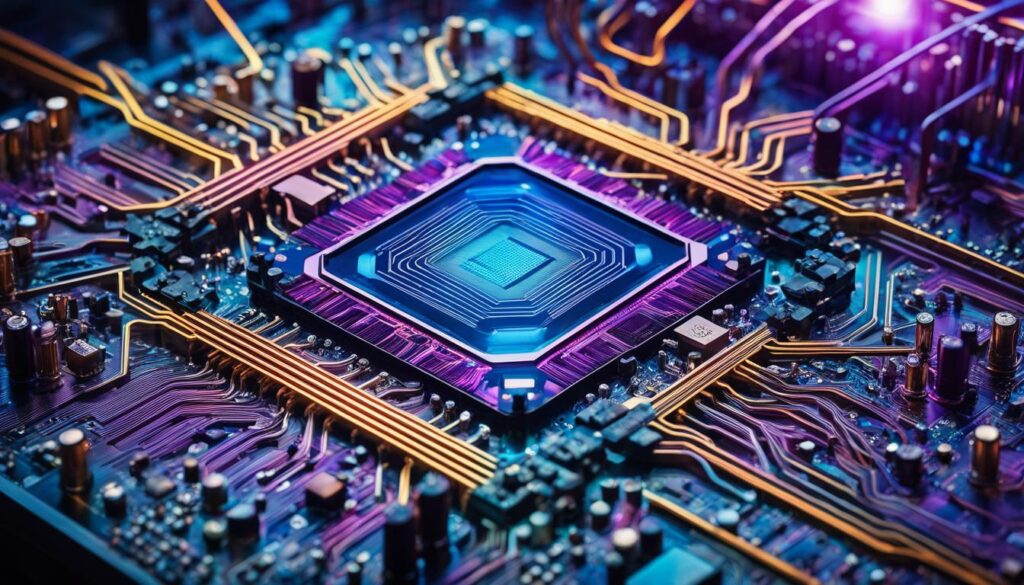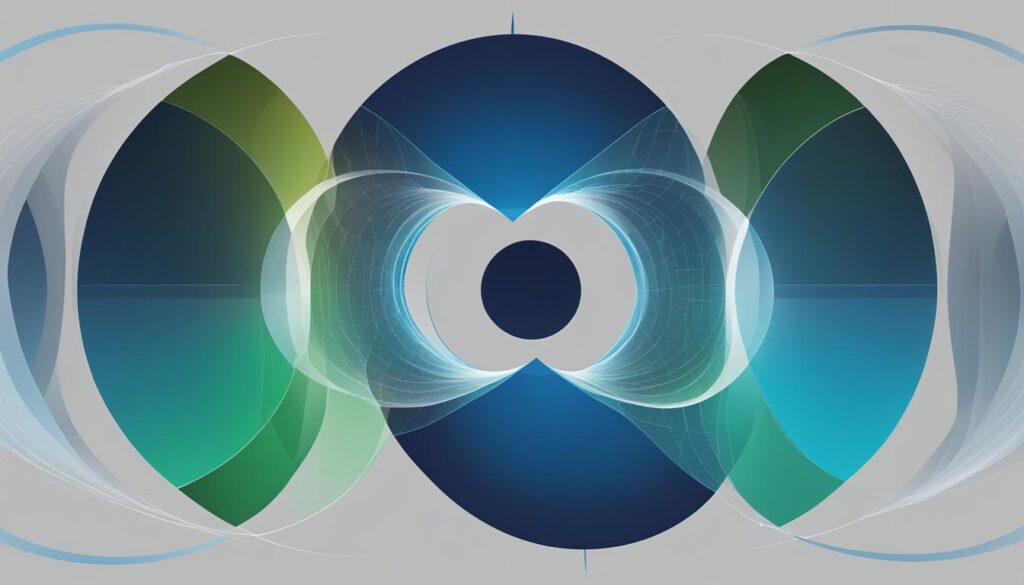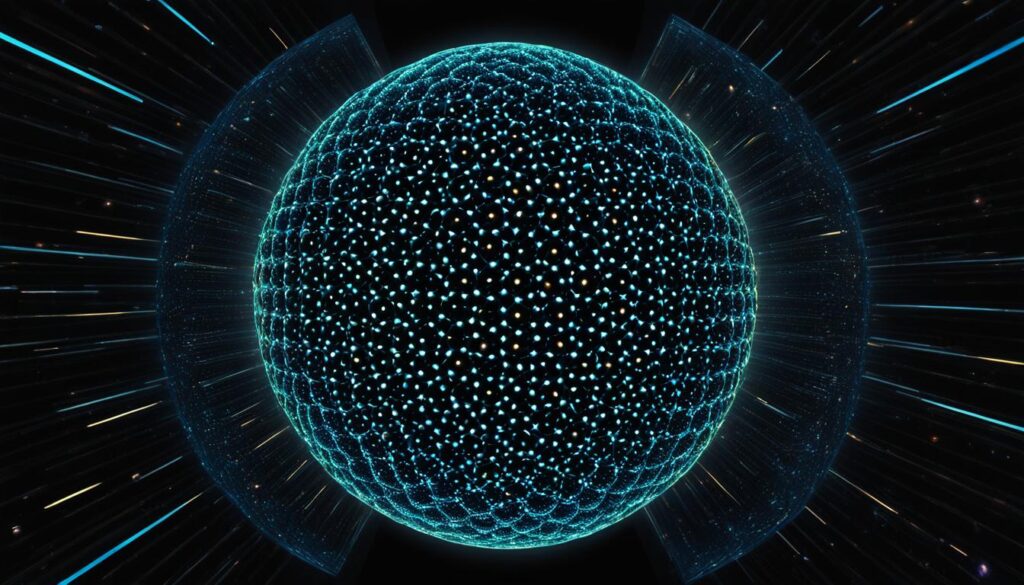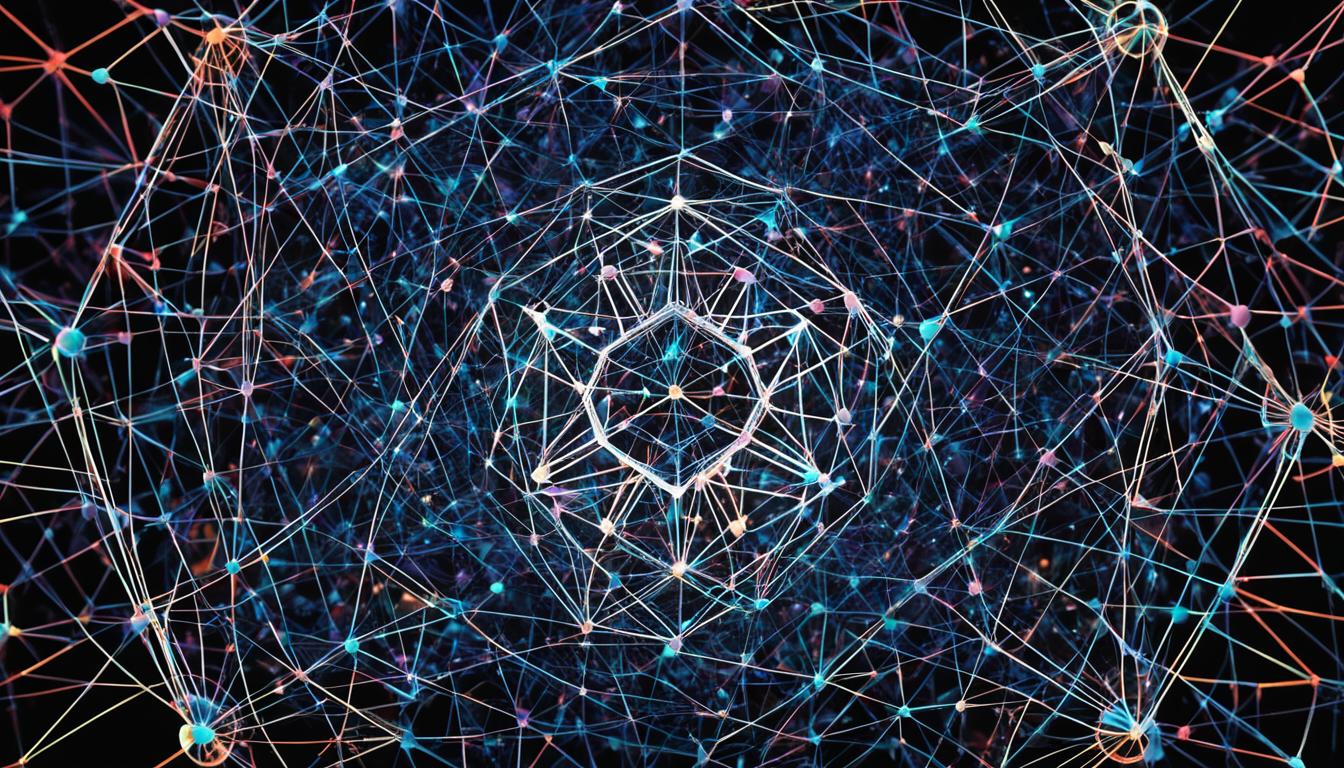The advent of quantum computing complexities has spurred a scientific and technological revolution—a departure from classical systems into an era of computing bound by the peculiar laws of the subatomic. For those inquisitive about what does a quantum computer look like, the answer resides not in the realm of the familiar but in the architectural marvels of quantum mechanics embodied in hardware. This visual guide to quantum computers invites you to unravel the enigma of devices that are not mere processors, but the alchemists of information science, shaping what once was theoretical into a palpable future.

The promise of quantum computing hinges on its ability to harness ‘quantum weirdness’ – phenomena that traditional computing cannot exploit. From the aspiring physicist to the seasoned tech enthusiast, understanding these arbiters of quantum computing complexities can be both a challenge and a marvel. Their appearance, an aesthetic fusion of science and art, stands as a testament to the groundbreaking work of countless researchers. This guide aims to be your compass in navigating the intricacies of these pioneering machines, unfolding the visual tapestry of quantum computing.
An exploration of the quantum computing landscape reveals a deeply interconnected synergy of components that function under extreme conditions, echoing the strangeness of the quantum domain. What emerges is a computing behemoth with the potential to solve once-unsolvable problems, from molecular modeling to data encryption. Let us embark together on a visual journey, peeking within the depths of a machine that offers a panoramic view into the future of computational integrity and capacity.
Key Takeaways
- Quantum computers leverage the principles of quantum mechanics to tackle problems beyond the reach of traditional supercomputers.
- A visual guide into quantum computing reveals a strikingly different hardware aesthetic compared to familiar computing devices.
- The structural design of a quantum computer is an exquisite confluence of scientific ingenuity and elaborate engineering.
- Understanding the visual and operational aspects of quantum computers demystifies quantum computing complexities.
- This journey into the core of quantum ingenuity is foundational for grasping the transformative potential of quantum computers.
- The functionality and potency of quantum computers are potentiated by their distinct and highly specialized internal components.
Exploring the Quantum Realm: The Fusion of Physics and Computation
The seamless integration of quantum physics with computer science has birthed quantum computing—a groundbreaking field that pushes the boundaries of data processing and problem-solving. Where conventional computation meets its limits, quantum mechanics opens up a labyrinth of possibilities, allowing us to undertake tasks with unparalleled efficiency.
The Quantum Leap in Computing
Rooted in the fundamentals of quantum mechanics, quantum computing transcends the binary limitations of classical computers. In this advanced computing landscape, the attributes of quantum physics, such as entanglement and superposition, empower quantum bits (qubits) to operate in states that carry more information than binary bits. The result is a computational leap that harnesses the peculiar probabilities of quantum mechanics to process complex data at unprecedented speeds.
From Supercomputers to Quantum Supremacy
For years, supercomputers have stood as behemoths of processing power, tackling the most complex scientific and encryption problems. Yet, the quest for quantum supremacy—where a quantum computer performs a calculation beyond the reach of even the most powerful classic supercomputers—illustrates the striking potential of quantum computing to redefine the landscape of computation.
Decoding the Basics of Quantum Mechanics
The intricacies of quantum mechanics form the bedrock of quantum computing. A fundamental understanding of this domain is essential to grasp how quantum computers manipulate information. Unlike classical systems, quantum mechanics suggests that particles exist across a probability of states, not in a fixed position or time. By embracing this counterintuitive concept, quantum computers unlock a new dimension in solving intricate problems, optimizing computations beyond the scope of classical approaches and accelerating scientific discovery.
The Quantum Evolution: A Brief History
The voyage through quantum computing history is akin to exploring uncharted territories, where the principles of reality are fundamentally challenged and reimagined. It is here that quantum technology pioneers have transcended traditional paradigms to craft what was once thought impossible. This section delves into the historical tapestry of quantum theory and its inextricable link to the dawn of commercial quantum computing.
In tracing the origins of this radical frontier, we unearth a saga that begins in the depths of quantum theory’s perplexing domain. The story unfolds in the early 20th century, where the reverberations of quantum mechanics began to disrupt classical physics. This was a time of intellectual ferment, wherein the fundamentals of computing were yet to find their quantum muse.
Theorizing the Quantum Future: Pioneers of Quantum Computing
It was the intellectual rigor of figures like Paul Benioff who first proposed utilizing quantum mechanics for computation. His vision set a precedent that would attract fellow luminaries, such as Richard Feynman, whose wit and ingenuity brought the term ‘quantum computer’ to the fore, firmly rooting it in the collective consciousness of the scientific community. Nobel laureate Feynman, alongside David Deutsch at Oxford, whose work on quantum computational networks provided a skeletal framework, were both instrumental in bridging the chasm between abstract quantum mechanics and practical computation.
The seminal contributions of Peter Shor introduced a groundbreaking algorithm, sparking a revelation in the cryptographic community with its potential to effortlessly decipher encrypted keys that would otherwise require centuries to unravel using classical computers. This pivotal moment signified not only a theoretical leap but also sowed the seeds for a future where quantum computing could be industrially and commercially viable.
From Academic Concepts to Commercial Ambitions
The trajectory from academia to industry was marked by robust experimentation and escalating investments. Technology titans have since taken the helm, with entities such as Google and IBM advancing the quantum computing frontier. These tech behemoths recognize the transformative implications quantum computers portend for a myriad of industries, from pharmaceuticals to aerospace, thereby pouring substantial resources into this endeavor.
Quantum theory’s transition to practical, commercial quantum computing is underscored by a burgeoning interest from diverse sectors, seeing past the abstract complexities and focusing on the tangible, imminent revolutions the technology promises. The fiscal year 2022 epitomized this momentum with a record infusion of $1.8 billion of venture capital into quantum computing enterprises globally. This quantum leap reflects a broader, more ardent acknowledgment—and anticipation—of these unprecedented machines’ imminent integration into the fabric of society and industry.
Distinguishing Quantum Computers: Form and Function
In the evolving landscape of quantum technology, the unique quantum computer design is as much a marvel of engineering as it is a leap in computational power. Unlike the personal computers that sit on our desks, quantum machines represent an intricate dance between physics and innovation, where each component plays a critical role in the orchestration of quantum processes. To comprehend the scale and structure of these devices begs the question: how large is a quantum computer?
A quantum computer defies conventional aesthetics with a design reminiscent of something out of a futuristic muse. It is not defined by the size but by the architectural complexities necessary for its operation. This complex ensemble of delicate hardware is meticulously enveloped in a glass case—a transparent fortress shielding it from the environment and preserving the exceptionally low temperatures of near-absolute zero required for quantum supremacy.
Why does such a sophisticated machine need such precision in its environment? The answer lies in the quantum components’ vulnerability—the qubits. Maintaining the fragile quantum states essential for these computers to function necessitates the creation of a highly controlled setting. Consider this: at the heart of these systems lies the ability to process several computations simultaneously, a feat unattainable by traditional systems. This harbinger of computational potential, however, is only possible under strictly regulated conditions far removed from the disturbances of our macroscopic world.
| Feature | Description | Relevance to Quantum Computing |
|---|---|---|
| Physical Size | Varies from the size of a large cabinet to a full room | Spaces are tailored to house cooling systems and isolation structures |
| Design Complexity | Network of metal tubes, wires, and shielding | Reflects the intricacies of maintaining superconducting qubits and shielding from interference |
| Temperature Requirement | Near absolute zero conditions | Enables delicate quantum states to be preserved for operation |
| Environmental Isolation | Encasement in robust, transparent materials | Limits exposure to external factors like dust and electromagnetic noise |
The sheer scale of a quantum computer’s design is not only an artifact of scientific endeavor but also a clear indicator of its capabilities. As with all things quantum, what’s on the inside counts for transformative processing power, an aspect where size does indeed matter — the larger the quantum structure, the greater the number of qubits it can potentially house. Yet, bound in a paradox, these colossal structures must operate under the most minute and precise conditions humanly achievable to unlock the full spectrum of quantum computing’s promise.
Quantum Processor: The Core of Quantum Ingenuity
The quantum processor stands as the central nexus of a quantum computer, where the enigmatic laws of quantum physics are harnessed to perform calculations with astonishing speed and complexity. This intricate component is often compared to the brain of a classic computer, but it operates according to principles that defy classical norms, employing quantum weirdness to achieve feats previously unimaginable.
The Role of Qubits in Quantum Calculations
In the heart of the quantum processor, you will find qubits—the cornerstone of quantum computing. These units of quantum information differ from classical bits, embodying the capability to occupy multiple states simultaneously through superposition. This quality allows for multi-qubit operations, where an increasing array of interactions between qubits leads to exponential growth in computing power.
Superconducting qubits, in particular, have taken the spotlight in the race towards quantum supremacy. These qubits require extreme environmental controls to maintain their fragile quantum states, operating at temperatures nearing absolute zero. Only in these conditions can the superconducting qubits fully exhibit the peculiarities of quantum mechanics, essential for carrying out sophisticated quantum algorithms.
Scaling Up: The Future of Quantum Processors
The expansion of quantum computing power is directly linked to the ability to scale quantum processors with an increased number of qubits. As research progress, the next generation of quantum computers will contain processors capable of supporting thousands, if not millions, of interconnected qubits, greatly amplifying their capacity for multi-qubit operations.
The task ahead for scientists and engineers is colossal and yet thrilling—a pursuit to refine the architecture of quantum processors to accommodate a greater qubit count while preserving operational integrity. This evolution is projected to journey beyond isolated computational novelties into a realm where quantum processors coalesce to address challenges in drug discovery, financial modeling, and climate simulations with unprecedented precision.

As the field continues to mature, the pioneering architectures such as the lattice of microwave resonators, pivotal for qubit entanglement and coherency, ensure that the quantum processor will remain a bastion of scientific fascination and the beacon of quantum breakthroughs. With every added qubit and every advancement in superconducting technology, we inch closer to unlocking the boundless potential of quantum computation—a testament to human ingenuity and the inexhaustible spirit of exploration.
What Does a Quantum Computer Look Like
Quantum computers embody a radical shift from the aesthetic conventions of traditional computing machinery, veering into the surreal. The question of what a quantum computer looks like is answered not through descriptions of commonplace circuitry and monitors, but by delving into a world where quantum computer aesthetics define a new visual language of technological prowess.
The Unconventional Aesthetics of Quantum Machines
The first encounter with a quantum computer is akin to stepping onto the set of a futurist film—electronic components orchestrated into a symphony of metallic sheens and geometric precision. The external guise of the quantum machine is a harmonious blend of functionality and surreal design, requiring a degree of environmental control unimaginable in contemporary computing devices.
Visualizing the Quantum Workhorse
Aesthetics in the realm of quantum devices transcend mere appearance; they are an integral part of the machine’s operational fabric. The architecture, seemingly abstract, fulfills the critical task of isolating the quantum processors from environmental disturbances such as heat and electromagnetic noise. The intricate arrangement of parts reveals the beauty of a system devised to unlock and manipulate the very subtleties of quantum states for impactful computation.
Visualizing what a quantum computer looks like necessitates appreciation of both the seen and the unseen. It involves recognition of the artful care with which every wire and component is placed, to achieve not only technical performance but also to pay homage to an elegance that hints at the quantum computer’s revolutionary potential.
Understanding Qubits: The Building Blocks of Quantum Computing
As we delve into the realm of quantum computing, it becomes essential to comprehend the elementary components that make such technology possible—quantum bits, commonly known as qubits. Unlike the bits in classical computers that operate in a strict binary state of 0 or 1, qubits possess an extraordinary capability. Due to qubit superposition, these entities can simultaneously hold an amalgamation of both states, existing in a probabilistic state where they are neither and both until measured. This quantum phenomenon is the crux of what gives quantum computing its advanced capabilities, revolutionizing how we envisage computational processes and quantum information.
The intricate nature of qubits as carriers of quantum information invokes a beautiful symphony of uncertainty and possibility. These foundational units empower quantum computers to solve complex problems with an efficiency and speed that eludes classical computational machines. Yet, in the tangible world, these abstract concepts remain unseen to the naked eye. Qubits are often metaphorically visualized through various representations, such as the spin of an electron or the polarization of a photon. Despite their intangible nature, the role of qubits in quantum mechanics and technology is unmistakably concrete and transformative.

Consider the following comparative illustration of quantum bits and classical bits:
| Aspect | Classical Bit | Quantum Bit (Qubit) |
|---|---|---|
| State | Exists either in 0 or 1 | Exists in a superposition of probabilities for 0 and 1 |
| Information Storage | Limited to one state | Multi-state through superposition, enabling richer information density |
| Computing Power | Limited to linear scaling with bit increase | Exponential scaling with qubit increase due to entanglement and superposition |
| Visual Representation | Binary code as 0s and 1s | Metaphorical depictions (spinning globes, energy levels) |
The potential of qubits to serve as the backbone for a new era of computing is underscored by their versatility and the profound implications they hold for quantum information systems. While the world is still on the cusp of fully realizing the vast horizons that qubit superposition can take us to, the current strides made in quantum computing signal a future replete with unimaginable technological advancements. The continued exploration and understanding of qubits stand as a beacon of innovation, promising breakthroughs that will redefine the very essence of computation.
Cooling Systems: Creating a Near-Absolute Zero Environment
As the quantum computing era progresses, the paramount role cooling systems play in preserving quantum coherence and functionality has become increasingly apparent. With quantum processors capable of unlocking new capabilities in data science, one of the most intriguing appliances that has emerged is the dilution refrigerator. This marvel of engineering is not simply a component; it is the lifeline of quantum computers, maintaining the operational temperatures required for cooling quantum processors.
Inside the Dilution Refrigerator: The Coldest Place in Tech
Within the imposing structure of the dilution refrigerator, temperatures plunge to realms colder than the furthest reaches of outer space. Charged with the critical task of cooling quantum processors, it is here, among the shielded multilayered chambers, that quantum coherence is nurtured. As tall as a person, the dilution refrigerator serves as the environmental chrysalis, fostering the fragile conditions necessary for quantum computation.
Maintaining Quantum Coherence: The Battle Against Heat
At the core of quantum computing’s distinctive needs is the battle against heat. By establishing a near-absolute zero environment, dilution refrigerators safeguard quantum coherence, a state where qubits can interact without the disruptive noise of thermal energy. Achieving this impressive feat of thermal management is vital for sustaining the precise manipulation of qubits, ensuring each quantum operation’s integrity and paving the way for the progression of quantum computing technologies.
| Component | Function | Importance |
|---|---|---|
| Dilution Refrigerator | Cools quantum processors to near-absolute zero temperatures | Essential for preserving the quantum state of qubits |
| Shielded Layers | Isolate the quantum processors from external heat and electromagnetic noise | Prevent decoherence and operational interference |
| Thermal Management | Mitigates the impact of external and internal thermal energy | Ensures reliable and precise quantum calculations |
The intricacies of keeping a quantum system at its operational peak are mirrored in the complex design of the dilution refrigerator. It’s a titanic clash against nature’s inherent warmth; a conquest to maintain the quantum realm’s requisite icy calm. Both an engineering masterpiece and a foundational pillar in quantum technology, the dilution refrigerator embodies the ingenuity needed to herald a future where quantum computing can thrive.
Microwave Electronics: The Puppeteers of Qubits
Within the intricate workings of a quantum computer, microwave electronics serve as the critical interface between the esoteric world of quantum algorithms and the tangible, powerful alterations performed on qubits. These sophisticated electronics are the maestros conducting the symphony of qubit control, delivering precise microwave pulses that translate quantum instructions into reality.
Translating Algorithms into Quantum Actions
The journey from theoretical quantum algorithms to actual qubit manipulation rests in the capable hands of microwave electronics. Through microwave pulses, these electronics articulate the dense language of quantum computing into the qubit’s quantum state changes, initiating complex operations and computations. This quantum articulation is the heart of functional quantum computing, allowing algorithms to render the abstract into discernible outcomes.
Ensuring Clarity and Precision in Quantum Communications
The integrity of quantum communications is incumbent upon the absence of noise and external interference. In the distinctly delicate quantum environment, microwave electronics must operate with clinical precision. They are the guardians of clarity, employing superconducting cables to maintain a pristine line of communication between themselves and the qubits nestled within the refrigeration systems. It is the precision of these electronic signals that underpins the fidelity of qubit control and the successful execution of quantum algorithms.

| Component | Role in Quantum Computing | Significance to Qubit Control |
|---|---|---|
| Microwave Pulses | Transmit control signals to quantum processors | Enable precision in the manipulation of qubits’ states |
| Quantum Algorithms | Provide the blueprint for processing quantum information | Critical for defining the calculations and operations on qubits |
| Superconducting Cables | Interconnect microwave electronics and cooling systems | Essential for reducing noise and maintaining signal integrity |
Classical Computers: The Quantum Assistants
Though the realm of computation is being redefined by the enigmatic powers of quantum computing, the contributions of classical computers in quantum computing remain indispensable. These steadfast workhorses of the digital age have not been rendered obsolete; instead, they have become the unsung heroes, instrumental in initiating and interpreting the complex dance of quantum mechanics.
Programming the Quantum Revolution
Classical computers assert their relevance in the quantum sphere chiefly through the vital role of programming quantum computers. Far from being passive bystanders, they serve as the architects of quantum algorithms — translating human ingenuity into a syntax that quantum machines can comprehend and execute. The proficiency with which classical systems orchestrate quantum tasks underscores a nuanced collaboration between the deterministic world and the probabilistic quantum domain.
Interpreting Quantum Data through Classical Computation
The liaison between quantum brilliance and practical application is mediated by the foundational technology of classical computers. Their capability to interpret the quantum data output is just as crucial as launching quantum processes. By decoding the outcomes of elaborate quantum computations, classical systems present the results in a format that is intelligible, actionable, and valuable to researchers and industry professionals alike.
Here lies a nuanced synergy, a testament to the symbiotic relationship that drives the frontier of technology forward: classical computers, serving as the quantum assistants, are setting the stage for the quantum revolution — a paradigm where the variables of uncertainty and complexity are manipulated with unparalleled deftness and potential.
Quantum Superposition: The Enigma of Multiple States
In the quantum computing sphere, quantum superposition stands as one of the most enigmatic and essential principles. This phenomenon allows qubits to be in a state of multiple potentialities simultaneously, a cornerstone for the power and mystery that defines quantum computing.
Visual Representations of Quantum States
While the true state of qubits in quantum superposition eludes direct visual observation, scientists have devised diagrammatic representations to make this abstract concept more accessible. These representations often employ imagery like spinning globes or waveforms to symbolize the complex, probabilistic nature of a qubit’s existence.
Manipulating Reality: Tools and Techniques
The manipulation and measurement of qubits require a delicate interplay of highly specialized tools and techniques. In cutting-edge laboratories around the globe, scientists employ lasers, magnetic fields, or microwave pulses to interact with these enigmatic quantum states. Each method has evolved as part of a nuanced toolkit designed to control and observe the curious behavior of qubits without disrupting their fragile superposition.

As research progresses, the quantum state visualization techniques continue to advance, refining our ability to perceive and comprehend the multitudinous states that make quantum computing a reality. Unlocking the power of qubits through these techniques not only challenges our understanding of physics but also reshapes the future potential of computational sciences.
The Quantum Entanglement Phenomenon
Within the intricate quantum systems powering tomorrow’s computers lies a phenomenon as mystifying as it is fundamental—quantum entanglement. This principle is pivotal not only for understanding the operability of quantum mechanics but also for orchestrating the superior processing power of quantum computers.
Einstein’s “Spooky Action at a Distance”
Albert Einstein famously referred to quantum entanglement as “spooky action at a distance,” expressing incredulity at the idea that entangled qubits could influence one another instantaneously over vast distances. Despite Einstein’s reservations, this phenomenon has since been empirically verified and stands at the foundation of quantum mechanics.
Entanglement’s Crucial Role in Quantum Operations
Quantum entanglement is not just a theoretical curiosity—it is the engine behind the immense computational speed and power of quantum computing. By linking pairs or groups of entangled qubits, changes to the state of one are replicated instantaneously in its partner, no matter the physical separation. This property is what enables quantum computers to perform intricate computational operations unimaginably faster than their classical counterparts, truly distinguishing quantum entanglement as a cornerstone of future computing technologies.
Advancing Technology with Quantum Algorithms
The emergence of quantum algorithms marks a paradigm shift in the world of computing, ushering in a new epoch where the once-impassable limits of data encryption and molecular simulation are now surmountable. This leap in computational capabilities stems from the unorthodox principles of quantum mechanics, which enable quantum computers to tackle tasks that are prohibitively difficult—or impossible—for classical computers.
Breaking Codes and Modeling Molecules
At the forefront of quantum computing applications is the ability to break cryptographic codes, a feat that poses both opportunities and challenges for cybersecurity. As quantum algorithms, such as those designed by Peter Shor, become more refined, they present an accelerating pace of technology advancement with implications for national security and data privacy. Meanwhile, in the pharmaceutical realm, these algorithms facilitate the precise modeling of molecular structures, potentially expediting drug discovery and heralding a new era in medical research.

Envisioning the Impact on Various Industries
Quantum algorithms do not merely represent an incremental step in technological progression but a quantum leap for various industries. In finance, these algorithms hold the promise to optimize trading strategies and risk management through high-speed, complex calculations. Healthcare stands to benefit from enhanced imaging and personalized medicine, while energy sectors may see significant advancements in material science and energy storage solutions.
| Industry | Potential Applications | Expected Impact |
|---|---|---|
| Cybersecurity | Advanced cryptographic systems, Code-breaking | Higher security protocols and privacy paradigm shifts |
| Pharmaceuticals | Molecular modeling, Drug development acceleration | Faster time-to-market for drugs and tailored therapies |
| Finance | Risk assessment, Algorithmic trading | More robust financial models and reduced market risks |
| Energy | Material science, Efficient energy storage | Improved sustainability and innovative energy solutions |
The intellectual horizon of quantum computing is studded with transformative potential, yet practical and ethical considerations must govern its trajectory. The pace at which these quantum computing applications permeate society will be a measure of our collective ingenuity and foresight. As researchers and businesses continue to make strides in quantum algorithms, the promise of technology advancement beckons with the certainty of dawn after the long night of theoretical confinement.
Quantum Privacy and Security: A Double-Edged Sword
The dawn of quantum computing has cast light upon the dichotomy of technological progression. Where there is promise, there is peril, especially in the realms of digital security. As quantum computers garner the ability to unlock new dimensions of computational prowess, they inherently possess the capability to decipher cryptographic codes that currently protect the vast swathes of our digital lives. This conundrum poses a stark reflection on quantum security as not just an evolution, but as a double-edged sword that could cut deeply into the fabric of privacy risks in cyberspace.
The traditional bastions of data encryption, relied upon to secure everything from personal correspondences to state secrets, stand to be disassembled with alarming alacrity by quantum technologies. The algorithms at the heart of current encryption models—once deemed unbreakable—now face the anvil of quantum computing’s hammer, their once impervious fortitude brought into question. This shift evidences the urgency with which quantum-resistant cryptographic techniques need to be cultivated, to ensure the armory of security is one step ahead of the quantum curve.
In anticipation of this looming upheaval, experts are engaged in an arms race to develop encryption that can withstand the quantum onslaught. State-of-the-art quantum encryption methods, such as Quantum Key Distribution (QKD), offer a glimpse into a future secure against the quantum threat. Nonetheless, for broader adoption, the quest for scalable, quantum-resistant strategies remains at the vanguard of cybersecurity research.
| Cryptographic Technology | Current Status | Quantum Impact | Need for Quantum Resilience |
|---|---|---|---|
| Public Key Cryptography | Widely used for securing data | Potentially breakable by quantum computers | High priority for development of quantum-safe alternatives |
| Symmetric Encryption | Relatively secure with increased key sizes | Less susceptible to quantum attacks | Continued research for enhancement |
| Quantum Key Distribution (QKD) | In developmental and limited real-world use | Offers a quantum-secure communication method | Scaling and global standardization essential |
The balance between leveraging quantum computers for their immense potential and shielding our digital dominion against their intrusive capabilities will be a delicate dance of innovation and foresight. As both enterprises and individuals grapple with the burgeoning reality of quantum-induced vulnerabilities, the pursuit of quantum encryption resilience represents an imperative to maintain privacy and trust in an increasingly quantum-enabled world.
Quantum Security Measures:
- Establishing quantum-safe protocols
- Investing in research for post-quantum cryptography
- Broadening the implementation of Quantum Key Distribution (QKD)
- Developing hybrid security methods leveraging both classical and quantum technologies
As the advancement of quantum computing continues to accelerate, it beckons all stakeholders in the digital ecosystem to consider not only the profound capabilities but also the privacy implications poised to redefine the landscape of cybersecurity. It invokes a call to action for collaborative efforts across scientific and technological domains, seeking to armor our connected world against the inherent vulnerabilities that quantum computing can expose.
Potential and Limitations: The Quantum Computing Horizon
As the quantum computing epoch matures, it ushers in a dual narrative of groundbreaking possibilities and tempered expectations. Quantum hardware developments are reaching new milestones, yet the societal impact of quantum computing conjures a complex vista of opportunities and constraints. This duality underscores the journey ahead—a trajectory laden with innovation and steadied by realistic projections of its influence.
Projected Developments in Quantum Hardware
Researchers and industry magnates are joined in a concerted effort to propel quantum hardware into its next evolutionary phase. The goal is clear: lower error rates and fortify computational muscle to meet the exacting demands of the so-called dream algorithms. Achievements in this domain are pivotal, as they will dictate the pace and breadth of quantum computing’s integration into society.
Quantum error correction is a beacon of this endeavor, promising to stabilize the precarious quantum states that are vulnerable to the slightest environmental perturbations. Furthermore, exploring the potential of quantum machines without extensive error checking is seen as a stepping stone towards more robust quantum systems. These machines aspire to realize a quantum advantage even in their nascent forms, providing a glimpse into a future where quantum and classical computations coexist and complement each other in a symbiotic technological ecosystem.
Realistic Expectations for Quantum Contributions to Society
The impact of quantum computing on societal structures and industries could be profound, potentially redrawing the boundaries of feasible computation and information security. Nonetheless, astute observers recognize that such transformative power carries with it an equal measure of responsibility and realistic foresight. The technological marvels anticipated must be weighed against the practical readiness of society to adapt, adopt, and responsibly manage this new computing paradigm.
As strides are made in hardware and algorithm development, it is crucial to keep a lucid perspective on the immediate applications. While vast potential abounds, the current state of quantum computing is akin to a bud—poised to blossom but yet to unfurl in full splendor. The societal impact of quantum computing will likely unfold gradually, with incremental advancements leading the way to comprehensive integration across various fields such as cybersecurity, pharmaceuticals, and beyond.
| Aspect | Potential Impact | Current Limitations |
|---|---|---|
| Computational Power | Ability to solve previously intractable problems | Quantum decoherence and error rates limit large-scale applicability |
| Data Security | Potential to strengthen encryption methods | Risks of undermining existing cryptographic infrastructure |
| Material Science | Enables complex molecular simulations for material design | Dependency on advancements in algorithmic efficiency |
| Economic Models | Optimization of large-scale financial systems and risk management | Need for integration with existing economic frameworks and policies |
Reflecting on the potential societal impact of quantum computing, it becomes clear that the horizon is vast and dotted with milestones yet to be achieved. But the path leading there is marked by the steady beat of scientific rigor and the collective will to harness one of the universe’s most enigmatic forces for the greater good.
Conclusion
The dizzying quantum journey summary reveals it to be an intersection of theoretical physics and technological progression, conjuring a burgeoning future for computational sciences. Embarking on an exploratory voyage into the rich tapestry of quantum computing, we have unfolded layers of complexity, marveled at the fusion of subatomic peculiarities with computational might, and witnessed the nascent stages of a technology that promises to redefine reality’s fabric.
The Quantum Journey: A Recapitulation
Our journey began with the strange and wonderful rules of the quantum realm, where particles like electrons behave in ways that defy classical intuition, setting the stage for the quantum leap towards powerful computing solutions. We took a visual and conceptual tour of current quantum hardware, from the towering dilution refrigerators to the microscopic qubits, revealing the quantum computer’s unconventional design and the intricate efforts required to maintain operational precision.
What’s Next for Quantum Computers?
The future of quantum computers shimmers with potential. Ongoing research is pushing the boundaries, refining quantum algorithms, and striving for the elusive quantum supremacy. As the hardware matures and error rates decrease, the aspirational goals of quantum computing—rapid drug discovery, enhanced encryption, and solving intractably complex problems—come within reach. We stand on the cusp of a new era, where interdisciplinary applications of quantum technology could revolutionize industries and catalyze innovation far beyond our current capabilities. The quantum journey, exhilarating and rife with discovery, marches forward toward a horizon filled with groundbreaking promise.
FAQ
What does a quantum computer look like?
A quantum computer often looks like an intricate assembly of metal and cables encased in a glass chamber, designed to maintain the extreme cold and controlled environment required for its operations.
What are the complexities of quantum computing?
Quantum computing involves concepts like superposition, entanglement, and quantum interference, which require a deep understanding of quantum mechanics and sophisticated technology to manipulate qubits.
Can you provide a visual guide to quantum computers?
A visual guide would typically illustrate the quantum processor packed with qubits, the dilution refrigerator system for extreme cooling, and elaborate microwave electronics for qubit control, all within a clean and controlled lab environment.
How does quantum computing differ from classical supercomputing?
Quantum computing leverages quantum bits or qubits which can exist in multiple states at once, offering a significant speed-up for specific algorithms compared to traditional bit-based supercomputing.
What are the basics of quantum mechanics that underpin quantum computing?
Quantum mechanics fundamentals include principles such as superposition (qubits existing in multiple states), entanglement (qubits influencing each other instantaneously), and the ability to process vast amounts of data simultaneously.
Who are some of the pioneers of quantum computing?
Key figures include Paul Benioff, who proposed a quantum mechanical model of computers, Richard Feynman, who introduced the concept of a quantum computer, David Deutsch, who extended the theoretical framework, and Peter Shor, who developed the infamous factoring algorithm.
How large is a quantum computer?
The size of quantum computers varies, but the systems can be quite large, typically dominated by the dilution refrigerator which can stand as tall as an adult person, and the surrounding control electronics and shielding.
What role do qubits play in quantum calculations?
Qubits are the central units of quantum information which allow for the encoding of data in multiple states simultaneously, thus enabling quantum calculations with a potential for computational power not seen in classical computing.
How are quantum processors expected to scale in the future?
As technology advances, quantum processors are expected to scale by increasing the number of qubits and reducing error rates, leading to more powerful and reliable quantum computing systems.
What is the role of dilution refrigerators in quantum computing?
Dilution refrigerators create an ultra-cold environment necessary to maintain the quantum states of qubits, which is essential for quantum processors to function correctly.
Why are microwave electronics important in quantum computing?
Microwave electronics are used to send precise control signals to the qubits in the form of microwave pulses, which perform the quantum operations required to process information.
How do classical computers assist in quantum computing?
Classical computers are used to set up the problems, program the quantum algorithms, and interpret the output of quantum computers, acting as an essential bridge between quantum systems and human operators.
How is quantum superposition represented visually?
Although superposition isn’t directly observable, it is often diagrammatically represented with images such as a spinning globe to indicate the probabilistic nature of qubits’ states.
What is quantum entanglement?
Quantum entanglement is a phenomenon where pairs or groups of qubits become interlinked such that the state of one qubit can instantaneously affect the state of another, no matter how far apart they are.
How could quantum algorithms impact various industries?
Quantum algorithms have the potential to advance various sectors by enabling faster and more complex computing tasks, such as creating new materials, speeding up drug discoveries, optimizing logistics, and enhancing cybersecurity.
What are the privacy and security implications of quantum computing?
Quantum computing could create stronger encryption methods for enhanced security but also has the potential to break existing cryptographic defenses, posing a challenge to privacy and cybersecurity.
What realistic societal impacts could quantum computing have?
Quantum computing could radically transform areas such as medicine, through drug discovery; environmental science, through efficient material design; and computing, by solving problems intractable to classical computers, thus potentially contributing significantly to societal progress.


